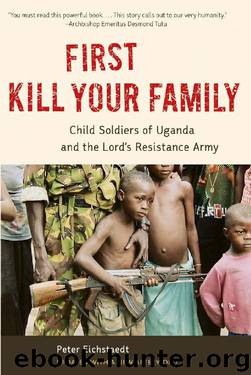First Kill Your Family: Child Soldiers of Uganda and the Lord's Resistance Army by Peter Eichstaedt

Author:Peter Eichstaedt [Eichstaedt, Peter]
Language: eng
Format: epub
Publisher: Chicago Review Press
Published: 2013-03-31T23:00:00+00:00
Ciprian Okello, a lean man with a quick smile and energetic eyes, was the leader of the Walela camp, created only two years earlier. “These people are ready to go back, but they fear. The rebels are malingering around.”
The camp residents survived on emergency supplies of corn and sorghum from the UN, but it was just enough to stave off starvation. The situation in the camp was desperate, and the Ugandan government was to blame, he said, and he scoffed at the government’s claims that people were returning to the land. “If the government wants the people to go back and resettle, we want to hear clearly that no rebels are around.” And he added, “We want enough materials to start living [again] in the villages.” No one in the camp had ever seen any government assistance. Neither had they been assured the rebels were gone.
As most refugees spoke fondly of a return to their lands, yet another land war loomed on the horizon with grave consequences for the already battered and decimated north. With the villages abandoned, the clans scattered, and the leaders dead and gone, the traditional Acholi system of land management was disintegrating. Like much of Africa’s communal system, lands had been managed and supervised on the local level by clan elders. Clans knew whose land was whose because they lived on it every day. And families within the clans also knew the boundaries of their lands because granting land was a decision made by the clan. It ensured that, as one generation followed another, the families would retain their rights to grow as large a garden as they needed and would have a place to house their goats and cows. Grazing lands were communal property, and as one clan and its herds grew, grazing land could always be a source of conflict. But it was a fully functioning system in which the clan made sure that any family’s lands were passed equitably to the next generation. Disputes were settled by the clans, and life moved on. There was enough room for all. If a family moved away, died, or disavowed its claims, the land reverted to the clan for the elders to redistribute. The system guaranteed the survival of the families and the clans, as everyone had a place to live and a place to grow their food. No one got richer than his or her neighbor, and no one starved.
But after twenty years of guerrilla warfare in the north, like most of everything else in Acholiland, the traditional system of land management had fallen apart. The clans were dispersed. Clan leaders had been killed or had died or, if alive, had now scattered to various camps. Traditional Acholi life had fallen into disarray. In the midst of this chaos, the government proposed a new system of land management in the north, providing land titles for returning villagers. The individual deeds would be recorded with government land agencies and would give one person something of value that could be used as capital or collateral.
Download
This site does not store any files on its server. We only index and link to content provided by other sites. Please contact the content providers to delete copyright contents if any and email us, we'll remove relevant links or contents immediately.
| Africa | Americas |
| Arctic & Antarctica | Asia |
| Australia & Oceania | Europe |
| Middle East | Russia |
| United States | World |
| Ancient Civilizations | Military |
| Historical Study & Educational Resources |
Goodbye Paradise(3464)
Men at Arms by Terry Pratchett(2686)
Tobruk by Peter Fitzsimons(2381)
Arabs by Eugene Rogan(2198)
Pirate Alley by Terry McKnight(2132)
Borders by unknow(2122)
Belonging by Unknown(1737)
It's Our Turn to Eat by Michela Wrong(1596)
The Biafra Story by Frederick Forsyth(1566)
Botswana--Culture Smart! by Michael Main(1488)
The Source by James A. Michener(1462)
A Winter in Arabia by Freya Stark(1450)
Gandhi by Ramachandra Guha(1437)
Coffee: From Bean to Barista by Robert W. Thurston(1423)
Livingstone by Tim Jeal(1396)
The Falls by Unknown(1374)
The Shield and The Sword by Ernle Bradford(1316)
Africa: Altered States, Ordinary Miracles by Richard Dowden(1297)
Egyptian Mythology A Fascinating Guide to Understanding the Gods, Goddesses, Monsters, and Mortals (Greek Mythology - Norse Mythology - Egyptian Mythology) by Matt Clayton(1280)
